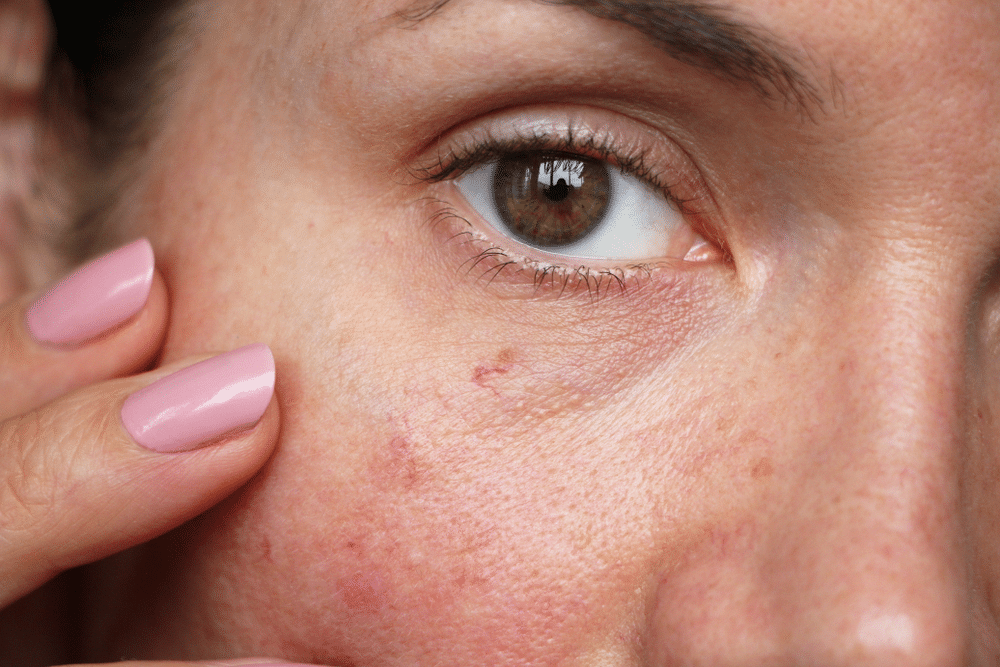Spider veins are an annoying, unsightly condition caused by tiny, dilated blood vessels. They can bother people no matter where they appear, but they’re particularly…
What Causes Spider Veins on the Face and How Can You Treat Them?

Spider veins are an annoying, unsightly condition caused by tiny, dilated blood vessels. They can bother people no matter where they appear, but they’re particularly prominent when they appear on your face.
Facial spider veins are also called “telangiectasis,” and, unlike varicose veins, they’re not usually dangerous or uncomfortable. However, they can make your face look red or pink, and the fine red lines are difficult to hide with makeup. Unfortunately, spider veins on the face will not resolve without treatment.
If you’re concerned about spider veins on your face, you have two options. First, you can prevent them from getting worse or forming in the first place. Second, you can treat the ones that have already developed. Here’s what you need to know about these annoying marks.
Causes of Spider Veins on the Face
Capillaries, the tiny blood vessels close to the surface of your skin, are delicate. It doesn’t take much for them to be dilated. Here are a few of the most common reasons you can develop telangiectasis on your face:
- Sun exposure: UV rays aren’t just bad for your skin — they also affect your surface blood vessels. Too much sun exposure can damage the capillaries in your face and cause spider veins.
- Pregnancy: When a person gets pregnant, their blood volume increases dramatically. This can put pressure on the veins in the face and cause permanent spider veins.
- Alcohol consumption: Drinking alcohol raises your blood pressure and causes your blood vessels to dilate. Drinking alcohol regularly can make that dilation permanent.
- Skin conditions: If you have acne, rosacea, or eczema, the skin on your face is probably flushed and irritated regularly. That irritation can lead to damage to your capillaries over time.
- Aging: Some people are biologically prone to spider veins. For these people, the marks will generally start to appear as they get older.
Avoiding sun exposure, drinking in moderation, and treating other skin conditions can help you avoid developing more spider veins. However, this won’t reverse the veins you’ve already developed. The only way to remove these veins is to shrink them or encourage your body to break them down.
Diseases That May Cause Facial Spider Veins
Sometimes, spider veins can be a symptom of something more serious. Anything that affects your circulation or your skin can possibly lead to spider veins in your face. A few conditions that may cause telangiectasis include:
- Lupus
- Bloom syndrome
- Scleroderma
- Sturge-Weber disease
- Xeroderma pigmentosum
- Certain types of cancer
- Lack of exercise
- Liver damage
It’s rare that you would identify any of these conditions through the appearance of spider veins. They all have other symptoms that are more obvious. However, if you’ve recently started developing spider veins, it doesn’t hurt to ask your doctor about possible causes.
Treating Facial Spider Veins
There are plenty of options for treating spider veins. The goal of these treatments is to reduce the appearance of any capillaries that are currently dilated and to keep them from reopening. Depending on your skin and the location of your spider veins, you may choose one of the following treatments:
Vein Laser Treatment
With cutaneous laser treatment, a medical laser is used to heat just the spider veins. The heating process causes the trapped blood to coagulate. As your body heals and removes this coagulated blood, it also breaks down the capillary so it’s no longer visible. This treatment takes several appointments to fully achieve results.
Intense Pulsed Light (IPL)
This is an alternate version of laser treatment. It focuses on the veins on the very surface of your skin, delivering more highly targeted energy to just those capillaries. Like vein laser treatment, it coagulates and blocks the visible capillaries so they break down. IPL uses a wider range of light energy than laser technology and covers more skin at once, so it can resolve spider veins in less appointment time than vein laser treatment.
Ohmic Thermolysis With VeinWave or VeinGogh
Unlike other treatments, ohmic thermolysis can help resolve spider veins in just one or two sessions. During this treatment, the vein specialist will insert microneedles into your skin. The needles aim FDA-approved microwave rays at the problem areas, triggering your body to shrink and break down spider veins. This process breaks down the offending capillaries more quickly than other methods, so you get clear skin in less time.
Sclerotherapy
Sclerotherapy can be an effective method to use in coordination with other treatments. Your vein specialist will inject a special solution into your spider vein that causes it to immediately collapse. Your body will then heal the vein and cause it to fade away. Sclerotherapy is most effective on smaller, thinner veins, so doctors may use it to clean up veins that remain after other treatments like vein laser treatment have been used.
Take Back Your Face
If you’re considering treating spider veins on your face, you should always get advice from a doctor. A vein specialist can help you find the best treatment for your situation.
If you need help finding a local vein specialist, My Vein Treatment’s locator tool makes it easy for you. Just put in your ZIP code and you’ll receive a list of trusted, experienced vein experts near you. Don’t let your spider veins hold you back. Schedule your treatment today.






Responses